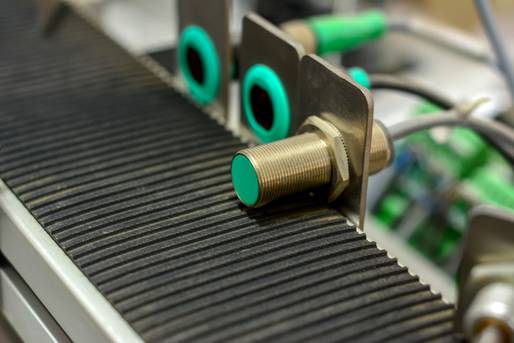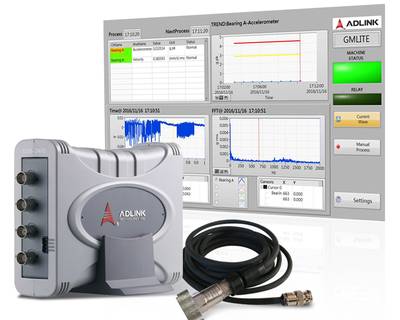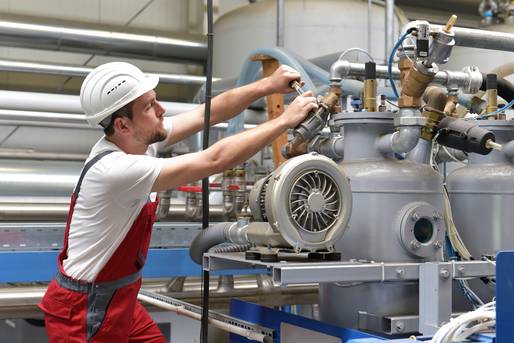Condition monitoring » Continuous condition monitoring of machines and systems
Published: 17.01.2023 | Reading Time: 6 minutes
This text is machine translated.
Whether large corporations, medium-sized companies or small businesses, manufacturing products is an enormous challenge for employees every day. In addition to real market assessment and sales planning, production must also run smoothly. Especially when demand is high.
This is why unforeseen downtimes in production are an absolute nightmare for the people responsible. After all, delivery deadlines must be met and the promised quantities must be guaranteed. Even though many companies have comprehensive production planning, sudden downtimes of machines and production systems are definitely not calculable. Or is it?
Sure, you can allow for certain “break times” between orders for possible maintenance when planning. But this reduces efficiency and profitability, which ultimately no company can afford. Condition monitoring (CM) would be a far better solution. In our guide, we explain what is meant by a condition monitoring solution, how it works and what benefits it brings.
A drive system, a production machine or a complete production line always have one thing in common, regardless of their different functions: in order to fulfill the required task, a large number of different components must work together smoothly. And the more complex the work processes are, the more important it is for the operating personnel to constantly check that everything is functioning correctly. Good people can often tell by the sound of the operating noises whether the machine they are operating is running correctly or whether something is wrong. They recognize even the slightest deviations and can intervene at an early stage to prevent major damage and downtime.
However, this requires years of experience. In addition, not all changes are easily noticed by the people operating the machine. Especially when it comes to electrical parameters that change or when a change only occurs very slowly. In this case, condition monitoring, i.e. precise electronic condition monitoring, can help.
To this end, machines and systems are equipped with a wide variety of sensors that continuously record all parameters relevant to operation. With the help of these sensors, even slow changes in machines and systems or an otherwise imperceptible increase in power consumption can be detected early and beyond doubt.
In order to be able to carry out meaningful condition monitoring, a few points need to be clarified so that implementation can take place quickly.
Areas of application and measured variables
The condition monitoring of machines and systems requires a certain amount of planning in advance. After all, comprehensive monitoring of all machines and systems, including the building technology, is definitely a very costly affair.
For this reason, condition monitoring should preferably be carried out on the systems that play an important role in the company's competitiveness.
It is then necessary to define exactly which physical relationships are important and which physical variables or measured values need to be recorded on the respective machines.
External influences
External influences must also be taken into account when monitoring the machine. Otherwise, a forklift truck passing nearby can very quickly lead to incorrect measurement of a vibration sensor or to the permissible limit values being exceeded.
Sensor installation
The appropriate sensors must then be selected according to these specifications.
The sensors can be connected to the evaluation unit either by cable (PLC and bus connection) or wirelessly (wireless network, cloud gateway, cloud or IoT).
However, the selection and installation of the sensors must be carefully considered.
This is because it is not always easy to lay cables and reliable wireless connections in industrial environments can be a real challenge.
Display of the measured values
The recorded sensor values should then be clearly displayed on a dashboard so that the responsible persons can interpret them correctly.
Once the “normal” operating parameters have been defined and the permissible limit values have been precisely specified, the software can behave like a person experienced in handling the machine or system.
Even minor deviations from the standard values result in feedback so that further measures can be initiated
Data evaluation
Ideally, condition monitoring is carried out in close cooperation with the manufacturer of the production system. This allows them to provide support during setup if necessary and to access the system's current operating data later during remote maintenance. However, sufficient data security must be ensured in this case.
In addition to monitoring the current operating data, data storage also enables long-term monitoring of the machine parameters. This means that even slow changes in the parameters caused by wear and tear on individual components can be reliably detected and the necessary maintenance work can be initiated.
Summary of the main groups
For a better overview, we have briefly summarized the main CM groups once again:
Sensor technology:
Sensors record certain measured variables and convert them into an electrical signal. Possible sensors are, for example, current sensors, voltage sensors, vibration sensors, distance sensors, speed sensors, temperature sensors, pressure sensors or level sensors and proximity switches.
Network:
The sensors are connected to the condition monitoring system via the on-site industrial network. The network can be either wired or wireless, although experienced service personnel prefer the wired version for safety reasons.
Condition Monitoring System:
The CMS is the heart of the system and, as a physical evaluation unit, takes over the exact data acquisition and storage of the measured values. The condition monitoring system also enables practical display on various end devices.
Condition Monitoring Software:
Special program for displaying, analyzing and storing sensor data. While in-house solutions (on-premise) were previously preferred for storage, IoT and cloud solutions, as well as networked online condition monitoring, are now becoming increasingly popular. All in line with the Industry 4.0 trend.
The permanent comparison between the actual value and the target value enables a clear statement to be made about the current status of a production machine, for example.
The exact diagnosis of the results of the condition comparison can then be used to derive recommendations for preventive maintenance measures. This is all the more important as many machines are operated close to their performance limits on a daily basis.
The systems often run around the clock to ensure production. Unforeseen downtimes then very quickly lead to major complications, which can ultimately only be remedied by increasing labor and costs.
It would be better if damage could be detected at an early stage. And these are precisely the advantages of condition monitoring.
Advantages of condition monitoring
Competent machine monitoring
By displaying all current parameters, the people responsible for operation always have all the information about the current status of the respective system. Even without extensive general technical knowledge, these people can now immediately recognize whether a machine is working smoothly or whether there is a need for action in a particular area.
Early fault detection
Even if a system appears to be working perfectly, increased current consumption of the drive may indicate that the mechanism is not working properly. Even brief interruptions are reliably recorded and logged for subsequent troubleshooting. This means that the necessary service work can be carried out before a total failure occurs.
Precise error analysis
Troubleshooting a complex system is often time-consuming, as the cause of the fault cannot always be clearly identified. With some faults, it is also unclear whether it is a mechanical fault or an electrical problem. In this case, the stored measured values are a valuable aid for service personnel.
Optimization of service intervals
Continuous monitoring very quickly reveals where a system requires more maintenance and where maintenance intervals are less frequent. Maintenance that is individually adapted to the system reduces service-related work to the required minimum without compromising the overall condition of a system.
Minimization of downtimes
Condition monitoring enables predictive maintenance, which significantly reduces the number of total failures and the associated downtimes. This ultimately leads to better utilization of production capacity and higher added value for the company. The investment will therefore quickly pay for itself.
Even if condition monitoring systems (CMS) require a certain amount of investment and expertise, there is no way around them in the long term. This is because the economic benefits of continuous condition monitoring during operation and the resulting predictive maintenance are undisputed. In addition, seamless condition monitoring enables predictable and therefore cost-optimized maintenance. Upcoming service work can be planned in advance and carried out during regular downtimes.
For this reason, new plants, machines and systems are equipped with the necessary sensors and interfaces ex works.
However, retrofitting existing systems, also known as brownfield systems, is also worthwhile. This is because maintenance or repair only as required, which is only carried out in the event of unplanned downtime, does not really help to safeguard production.
And preventive maintenance according to a maintenance schedule, as was often practiced in the past, is also increasingly uneconomical, as most components and lubricants that are still in good working order are replaced unnecessarily.
Alongside digitalization and networking, condition monitoring is one of the core elements of the evolutionary stage of Industry 4.0. As the advantages mentioned above clearly speak for themselves, CM is an important key technology and an absolute focus topic. However, condition monitoring does not protect against sudden events. These can occur, for example, if a gear wheel breaks suddenly due to a fault in the material. Material fatigue, on the other hand, is definitely the subject of CM by recording load values and load cycles.
Correctly set and defined operating parameters are also important. It is particularly important to set the appropriate limit values for retrofit systems, where it is necessary to fall back on tried-and-tested empirical values due to a lack of manufacturer specifications. If the tolerance values are set too low, the unnecessary and incorrect error messages will only disrupt the operating process. If the limits are set too high, an alarm message may be sent too late.
Another important point is the not inconsiderable amount of sensitive data that inevitably accumulates. Clear access rights must be assigned during use and it must be ensured that unauthorized persons do not have access during storage. Especially when people's company affiliations change. Common encryption methods must be used for the necessary data transfers.







